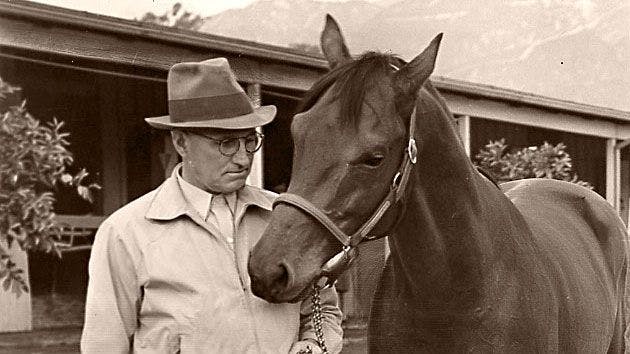Seabiscuit: 10 interesting facts about the legendary horse

Seabiscuit and Tom Smith (Wikimedia Commons/Seabiscuit Heritage Foundation)
Seabiscuit’s fairytale story made him a racing hero in the years immediately prior to World War II, and it was later turned into a popular book by Laura Hillenbrand, and from that, an Academy Award-nominated film starring Jeff Bridges, Chris Cooper, and Tobey Maguire.
Here are 10 interesting facts about America’s favorite equine underdog.
Today in 1937: Seabiscuit runs in the Brooklyn Handicap, beating rival Rosemont and local horse Aneroid. pic.twitter.com/TycbziKtYo
— TwinSpires Racing 🏇 (@TwinSpires) June 26, 2015
- He had a “cracker” name, inspired by his father: Seabiscuit’s sire was Hard Tack, a son of the all-time great racehorse Man o’ War. A hardtack is an inexpensive cracker, or “biscuit” (the English term for what Americans call cookies), used commonly during long sea voyages by sailors — hence it is also known as a “sea biscuit.”
- Seabiscuit lost his first 17 races: Many modern horses don’t have 17 races in their career, but Seabiscuit didn’t win until start No. 18. It came on June 26, 1935, as an early summer two-year-old. Today, those horses that have raced at that point in their lives are unlikely to have raced more than twice.
- He never raced in the Kentucky Derby: Though it is the most famous race in the United States, not all great horses run in the Derby. This is mainly because it’s restricted to three-year-old horses and held in early May; some horses, such as Seabiscuit, only display greatness at an older age. Other great champions that didn’t run in the Derby include Man o’War, Kelso, Dr. Fager, John Henry, Cigar, Tiznow, and Arrogate.
- A Hall of Fame trainer couldn’t tap into his potential: “Sunny Jim” Fitzsimmons was one of the greatest American trainers, preparing two Triple Crown winners (Gallant Fox and Omaha) and winning the earnings title five times. But he thought Seabiscuit was “lazy” and never got him to anything like champion level. For that, Seabiscuit would require a new stable, and a new trainer.
- He was bought for $8,000 as a three-year-old: Despite not showing great ability, unconventional trainer Tom Smith saw huge potential in Seabiscuit in June 1936 after a race at Suffolk Downs in Massachusetts. He convinced automobile magnate Charles S. Howard to buy the horse for $8,000 two months later. Seabiscuit could have been bought for $2,500 in claiming races as a two-year-old in 1935.
- He was helped by Pumpkin, Pocatell, and Jo-Jo: Smith helped Seabiscuit by feeding him a high-quality hay and letting him sleep in late. His comfort was aided by some helpful companions: an old horse named Pumpkin, a stray dog called Pocatell, and a spider-monkey called Jo-Jo. They helped him become more relaxed at home and more focused on race day, and by the end of 1936 he had become a very good horse.
- His regular jockey only had one eye: Smith paired Seabiscuit on the track with a down-and-out Canadian jockey called John “Red” Pollard. He lost vision in an eye early in his career and didn’t tell anyone, and it may have cost him and Seabiscuit the 1937 Santa Anita Handicap, when Pollard didn’t see his challenger Rosemount until late. Smith stuck with Pollard, and together horse and rider won 18 races from 30 attempts.
- He won the “Race of the Century”: In 1937, aged four, Seabiscuit won 11 of his 15 races and was the leading money-earner, but missed Horse of the Year honors to 1937 Triple Crown winner War Admiral. Fans clamored for a match race in 1938 between Seabiscuit and War Admiral, and it finally happened at Pimlico on November 1, in front of 40,000 people. Seabiscuit unexpectedly took the early lead and after War Admiral drew level in the back stretch, Seabiscuit pulled away in the final stretch and won by four lengths.
- He returned from injury a champion: Seabiscuit was hurt in his only 1939 start and many thought he’d be retired. But he returned as a seven-year-old in 1940, and finally, at the third attempt, won the Santa Anita Handicap. His retirement was announced soon after; at the time he was the highest earning racehorse in U.S. history, with $437,730. He won 33 races from 89 starts.
- Seabiscuit was bigger news than Roosevelt and Hitler: When researching her award-winning book on Seabiscuit, Laura Hillenbrand found that Seabiscuit was such big news that more newspaper column inches were written about him than President Franklin Roosevelt or Adolf Hitler. An estimated 40 million people listened to his match race with War Admiral on radio — including Roosevelt, who reportedly interrupted a cabinet meeting to hear the race.
ADVERTISEMENT



